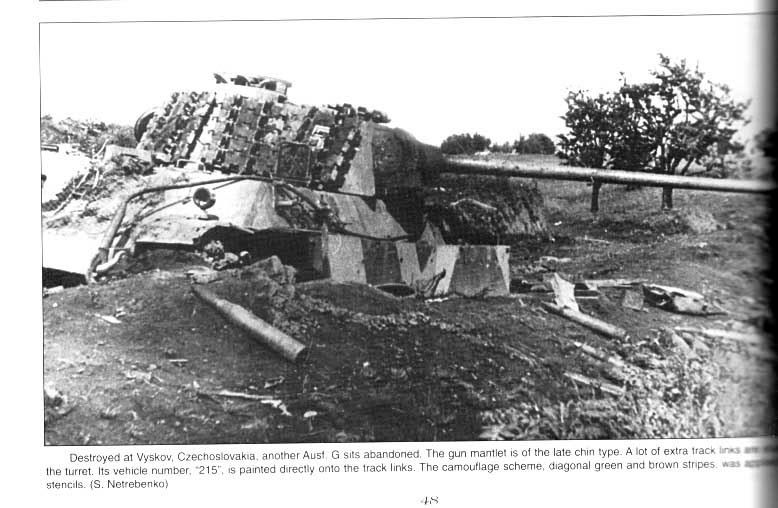It does not have zimmerit, which is all right because it represents a unit built after zimmerit use was discontinued in late 1944. It was alleged that the anti-magnetic paste was a fire hazard late that year and was no longer used, which somewhat simplified production of German armour in the last months of the war. I have read that Unimax was originally going to release 80026 (the first Panther) as an Ausf G used in Normandy 1944, but because they built it without zimmerit they could only release it as a late production model - hence the "Germany, 1944" and "Eastern Front, 1945" labels for both Panthers they have released so far.
Of course, most late production Ausf Gs were built with the new gun mantlet with the "chin" to prevent shot deflection into the forward hull's roof. I am disappointed that they released it without the anti-magnetic paste (they released all of their Tigers, King Tigers and Jagdpanthers with it - why not the Panther?) and that they chose not to build it with a more accurate gun mantlet with the "chin".
As to the diecast tank itself, it is fairly hefty and after disassembling it I found that the upper hull, turret, side skirts and gun barrel were all of stout metal construction. The gun mantlet, engine deck, front upper hull, lower hull and running gear are all of light plastic construction. It comes with two well-detailed landsers that are meant to be posed "taking cover" on the engine deck behind the turret. One is carrying a Kar 98K, the other a Sturmgewehr 44. There are no tank crewmen included, but the commander's hatch, radioman's hatch and driver's hatch all open if one wants to add crew later. The engine hatch opens to reveal a moderately detailed Maybach HL 230. The ball-mounted hull machine gun moves around freely and the travel lock for the main gun is moveable. The commander's hatch also has a rail-mounted (static) MG 34. The gun cleaning rods' tube is mounted on the left side of the tank, a further indication that this is an early Ausf G - later models had it mounted on the hull rear because it was vulnerable to damage while mounted on the side.
As to the gear mounted on the sides of the tank (as you would find on any WW2 German armoured unit), they are of plastic construction and appear to have been painted after they were mounted. As you can see in the photographs below, only the immediately visible parts of the mounted tools are painted gunmetal; the rest is unpainted - the original yellowish colour of the plastic can be seen.


What's worse is that the gun mantlet was installed upside down, and was in fact built to be installed upside down! It wasn't just a one-off manufacturer's mistake - as far as I know, all Panthers in this series are built with upside-down gun mantlets. You can tell because the gunner's sight is on the right side of the gun instead of the left, and the rain cover is underneath the sight instead of above it! Some careful surgery involving the removing of at least a dozen screws and the shaving off of a plastic tab inside the mantlet helped fix this error - it was about 20 minutes of work! Here is the corrected mantlet:

As you can see, the landsers look pretty good sitting on the engine deck. The commander's AAMG was hard to mount and almost wrecked the rail on the commander's cupola, plus the barrel of the MG was crooked! It was mounted successfully, though, and the gun barrel was straightened out with the help of some hot water.


All four of the hatches open. As you can see, the hatches are quite clearly the Ausf G type - they swing up and outwards and are much simpler than the earlier lift-and-rotate types of the Ausf D and Ausf A:

Rear hull, showing the "Type 2" exhaust outlets and jack stowage:

The main gun's working travel lock:

Front hull, showing the bow machine gun:

Note the four holes for screws holding the upper & lower hull together, the two holes for mounting the tank to its base and the larger central hole for the peg that keeps the turret immobile when it is on its base. The running gear works but tends to throw tracks fairly often. This isn't a problem, really, considering that it is not a toy:

When I first received this tank, I heard something rattling inside. Imagine my surprise when I found the plastic brace inside the bow of the tank broken! I believe this brace is meant to keep the drive sprockets moving together. However, the running gear works fine without this brace and it was removed altogether:


CONCLUSIONS
While there are some major flaws (upside-down mantlet, no zimmerit, troublesome AAMG, broken bit inside the hull, poorly painted hull-mounted gear) the intricate detail on the entire model is on par with that of every other vehicle in this line that I've seen. The only problems seem to be factory defects that have nothing to do with its design.
If one doesn't mind having to perform minor surgery on an expensive diecast miniature just purchased, the problems I've listed above shouldn't cause a headache. The Panther looks good sitting next to any other Forces of Valor 1:32 miniature. I consider it to be a worthy addition to my collection. Sit it next to a Tiger I or King Tiger, and you'll know what I mean! This steel Panther is huge!
However, I am looking forward to a better-manufactured Panther release in the future that includes zimmerit.






